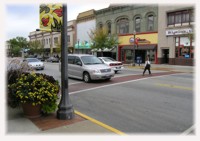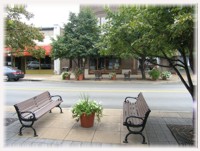In early 2006, East-West Gateway Council of Governments (EWG) launched the St. Louis Great Streets Initiative to expand the way communities think of their streets. Rather than viewing a roadway project as solely a way to move more cars and trucks faster, the goal of the St. Louis Great Streets Initiative is to trigger economic and social benefits by centering communities around interesting, lively and attractive streets that serve all modes of transportation.
More than 160 planners, engineers, city managers and elected officials  attended a Great Streets Symposium sponsored by EWG in October 2006. Attendees heard national and local experts discuss how a “Great Street” can stimulate sustainable economic activity, provide an aesthetically pleasing sense of place and still efficiently and safely move vehicles, pedestrians and cyclists.
attended a Great Streets Symposium sponsored by EWG in October 2006. Attendees heard national and local experts discuss how a “Great Street” can stimulate sustainable economic activity, provide an aesthetically pleasing sense of place and still efficiently and safely move vehicles, pedestrians and cyclists.
As a starting point, local leaders and their citizens need to ask what they want their transportation system to accomplish, including how better street design can connect residents with services, amenities and each other. This type of planning requires thinking beyond the curb to see how transportation decisions affect development and how streets affect nearby residents and those in surrounding communities.
In February 2007, a technical workshop was held to assist local communities to design their own “Great Streets.” Later that year, the Digital Design Guide made its debut.
 Since 2007, EWG has completed a total of 12 Great Streets projects in four rounds of funding Great Streets projects. In 2016, EWG initiated the fifth round of funding with the Forest Park Great Streets project that is scheduled to be completed in the fall of 2017. In 2017, the Kimmswick Great Streets project will begin with an estimated completion date in the fall 2018.
Since 2007, EWG has completed a total of 12 Great Streets projects in four rounds of funding Great Streets projects. In 2016, EWG initiated the fifth round of funding with the Forest Park Great Streets project that is scheduled to be completed in the fall of 2017. In 2017, the Kimmswick Great Streets project will begin with an estimated completion date in the fall 2018.
Beyond these demonstration projects, EWG encourages all communities to incorporate the Great Streets principles into their roadway projects. Through the Transportation Improvement Program (TIP) application process for Surface Transportation Program – Suballocated (STP-S), project sponsors are encouraged to include a discussion of how the project follows the Great Streets principles. The result has been more communities incorporating Great Streets principles into their roadway improvement projects.

